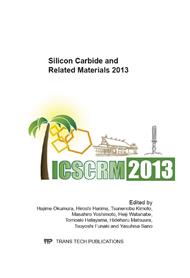[1]
M. Bakowski, P. Ericsson, C. Harris, S. Karlsson, S. Savage, and A. Schoner, Design and technology considerations for a RF BJT in SiC, Compound Semicond. 8 (2000), 75-79.
Google Scholar
[2]
Y. Tanaka, N. Kobayashi, H. Okumura, R. Suzuki, T. Ohdaira, M. Hasegawa, M. Ogura, S. Yoshida, and H. Tanoue, Electrical and structural properties of Al and B implanted 4H-SiC, Mater. Sci. Forum 338-342 (2000), 909-912.
DOI: 10.4028/www.scientific.net/msf.338-342.909
Google Scholar
[3]
M. Yazdanfar, S. Leone, H. Pedersen, O. Kordina, A. Henry, and E. Janzén, Carrot Defect Control in Chloride-Based CVD through Optimized Ramp up Conditions, Mat. Sci. Forum 717-720 (2012), 109-112.
DOI: 10.4028/www.scientific.net/msf.717-720.109
Google Scholar
[4]
A. Henry, J. ul Hassan, J. P. Bergman, C. Hallin, E. Janzén, Thick silicon carbide homoepitaxial layers grown by CVD techniques, Chem. Vap. Deposition 12 (2006), 475-482.
DOI: 10.1002/cvde.200606470
Google Scholar
[5]
H. Tsuchida, M. Ito, I. Kamata, and M. Nagano, Formation of extended defects in 4H-SiC epitaxial growth and development of a fast growth technique, Phys. Status Solidi B 246(7) (2009), 1553–1568.
DOI: 10.1002/pssb.200945056
Google Scholar
[6]
X. Zhang, S. Ha, M. Benamara, M. Skowronski, M.J. O'Loughlin, J. J. Sumakeris, Cross-sectional structure of carrot defects in 4H-SiC epilayers, Appl. Phys. Lett. 85(2004), 5209-5211.
DOI: 10.1063/1.1825072
Google Scholar
[7]
S. Ha, W. M. Vetter, M. Dudley, and M. Skowronski, A Simple Mapping Method for Elementary Screw Dislocations in Homoepitaxial SiC Layers, Mater. Sci. Forum, 389-393 (2002), 443-446.
DOI: 10.4028/www.scientific.net/msf.389-393.443
Google Scholar
[8]
Z. Zhang, Y. Gao, and T. S. Sudarshan, Delineating structural defects in highly doped n-type 4H-SiC substrates using a combination of thermal diffusion and molten KOH etching, Electrochem. Solid-State Lett. 7(2004), G264-G265.
DOI: 10.1149/1.1805500
Google Scholar


